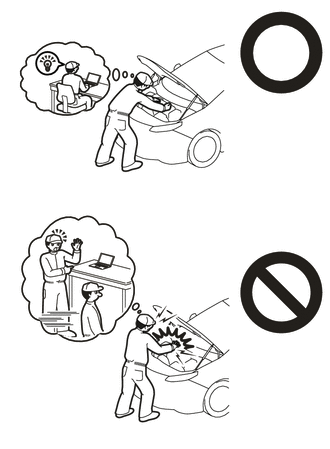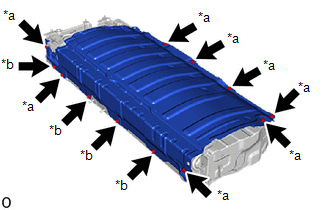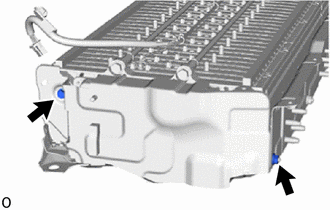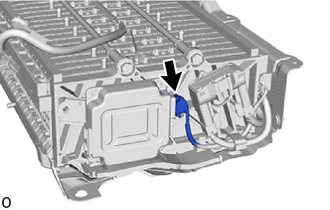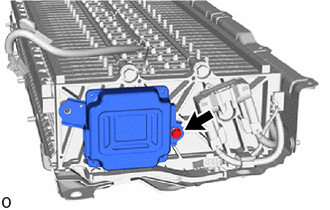| Last Modified: 01-30-2024 | 6.11:8.1.0 | Doc ID: RM100000001QKY7 |
| Model Year Start: 2021 | Model: RAV4 HV | Prod Date Range: [08/2020 - 12/2021] |
| Title: HYBRID / BATTERY CONTROL: BATTERY VOLTAGE SENSOR: REMOVAL; 2021 MY RAV4 HV [08/2020 - 12/2021] | ||
REMOVAL
CAUTION / NOTICE / HINT
The necessary procedures (adjustment, calibration, initialization, or registration) that must be performed after parts are removed and installed, or replaced during battery voltage sensor removal/installation are shown below.
Necessary Procedures After Parts Removed/Installed/Replaced
|
Replaced Part or Performed Procedure |
Necessary Procedures |
Effect/Inoperative Function when Necessary Procedures not Performed |
Link |
|---|---|---|---|
| *: When performing learning using the Techstream. | |||
|
Auxiliary battery terminal is disconnected/reconnected |
Perform steering sensor zero point calibration |
Lane control system |
|
|
Parking support brake system* |
|||
|
Pre-collision system |
|||
|
Lighting system (EXT)(w/ AFS) |
|||
|
Memorize steering angle neutral point |
Parking assist monitor system |
||
|
Panoramic view monitor system |
|||
|
Reset back door close position |
power back door system |
||
|
Back door lock initialization |
power door lock control system |
||
|
Replacement of HV battery |
Battery status info update |
HV battery status information cannot be updated |
|
CAUTION:
NOTICE:
-
After the ignition switch is turned off, the radio and display receiver assembly records various types of memory and settings. As a result, after turning the ignition switch off, be sure to wait for the time specified in the following table before disconnecting the cable from the negative (-) auxiliary battery terminal.
Waiting Time before Disconnecting Cable from Negative (-) Auxiliary Battery Terminal
System Name
See Procedure
Vehicle enrolled in Toyota Audio Multimedia system or safety connect system
6 minutes
Vehicle not enrolled in Toyota Audio Multimedia system and safety connect system
1 minute
- The type of battery voltage sensor to be used varies depending on the vehicle model.
-
The type of battery voltage sensor can be confirmed by the color of the label.
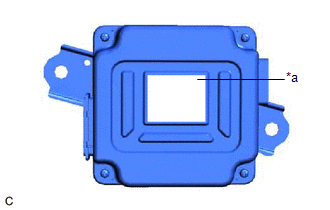
*a
Blue Label
- If the wrong type of battery voltage sensor is installed, the ignition switch cannot be turned on (READY).
-
After installing the battery voltage sensor, perform the following to check that the ignition switch can be turned on (READY).
- Turn the ignition switch on (READY).
- Turn the ignition switch off and wait for 30 seconds or more.
- Turn the ignition switch on (READY) again.
PROCEDURE
1. PRECAUTION
NOTICE:
After turning the ignition switch off, waiting time may be required before disconnecting the cable from the negative (-) auxiliary battery terminal. Therefore, make sure to read the disconnecting the cable from the negative (-) auxiliary battery terminal notices before proceeding with work.
2. REMOVE HV BATTERY
3. REMOVE UPPER HV BATTERY COVER SUB-ASSEMBLY
CAUTION:
Be sure to wear insulated gloves and protective goggles.
|
(a) Remove the 8 bolts, 4 nuts and upper HV battery cover sub-assembly from the HV battery. |
|
4. REMOVE NO. 1 HV BATTERY SHIELD PANEL
CAUTION:
Be sure to wear insulated gloves and protective goggles.
|
(a) Disengage the clamp. |
|
(b) Disconnect the battery voltage sensor connector.
|
(c) Remove the bolt and nut. |
|
(d) Remove the No. 1 HV battery shield from the HV battery.
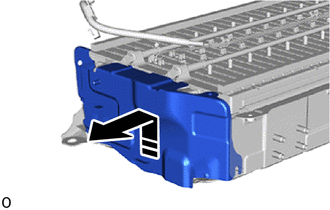

|
Remove in this Direction |
5. REMOVE BATTERY VOLTAGE SENSOR
CAUTION:
Be sure to wear insulated gloves and protective goggles.
|
(a) Disconnect the battery voltage sensor connector. NOTICE: Insulate each disconnected high-voltage connector with insulating tape. Wrap the connector from the wire harness side to the end of the connector. |
|
|
(b) Remove the bolt and battery voltage sensor from the HV battery. NOTICE: If the battery voltage sensor has been struck or dropped, replace it. |
|
|
|
|
![2019 - 2022 MY RAV4 HV [02/2019 - 10/2022]; PARK ASSIST / MONITORING: PARKING SUPPORT BRAKE SYSTEM (for HV Model): CALIBRATION](/t3Portal/stylegraphics/info.gif)
